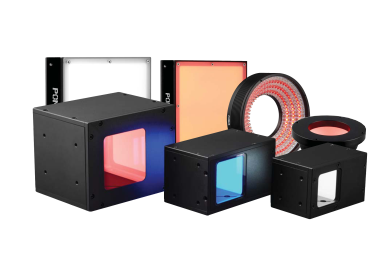Wavebands of visual light sources and their significance in visual inspection
Light is an electromagnetic wave that propagates as a wave. In the process of propagation, the length of a complete wave cycle of a light wave, i.e., the distance from one peak (or trough) to the neighboring peaks (or troughs), is known as the wavelength. Wavelength is an important parameter describing the properties of light and is usually expressed in nanometers (nm). The wavelength band of a visual light source refers to the range of wavelengths of light, a range that plays a crucial role in visual inspection.
The wavelength bands of visual light sources can be divided into several main categories: Visible, Infrared, and Ultraviolet. The wavelength range of light that can be perceived by the human eye is about 380nm to 780nm, which is known as visible light. Within this range, shorter wavelengths of light correspond to blue-violet colors, and longer wavelengths of light correspond to red colors. Visible light is the band of light we are most familiar with in our daily lives, and it allows us to see the world around us.


However, in the field of visual inspection, it is not enough to rely on visible light alone. The infrared band refers to the range of light wavelengths greater than 780nm, which is invisible but highly penetrating. Infrared light is often used in scenarios where the internal structure needs to be detected through a surface, such as detecting the inner screen size of an LED screen, or in the packaging industry to eliminate surface interference. With an infrared light source, the inspection system can penetrate the surface of the material and clearly capture an image of the edge of the inner screen or the internal structure, thus improving the accuracy and efficiency of the inspection.
The UV band, on the other hand, is the range of light with wavelengths less than 380nm, which is also invisible but has high frequency and energy. UV light is often used to excite certain substances to emit fluorescence or phosphorescence, thus realizing the detection of these substances. For example, in the 3C industry, a UV light source can excite the glue in the center of a tonearm coil to emit bright fluorescence, thus clearly presenting the outline of the glue and forming a clear contrast with the surface of the material for subsequent algorithmic detection.
In a visual inspection system, the light source not only provides illumination, but also acts as a signal reflector. The target to be detected will reflect part of the light, and these reflected rays contain the target's characteristic information. By capturing and analyzing these reflected rays, the visual inspection system can identify the shape, color, texture and other features of the target, and make further judgments and classifications based on these features. Therefore, the waveband selection of the light source will directly affect the quality and intensity of the signal reflection, which in turn affects the performance of the visual inspection system.
In practice, the waveband selection of the visual light source needs to be determined according to the material, color, characteristics and detection needs of the object to be detected. For example, for materials with smooth surfaces, selecting a high-angle visible light source may result in serious reflections, affecting the detection effect; while selecting a low-angle visible light source can eliminate reflections, but may not be able to penetrate the surface to detect the internal structure. In this case, an infrared or ultraviolet light source may be a better choice.
Product recommendation
TECHNICAL SOLUTION
MORE+You may also be interested in the following information
FREE CONSULTING SERVICE
Let’s help you to find the right solution for your project!


 ASK POMEAS
ASK POMEAS  PRICE INQUIRY
PRICE INQUIRY  REQUEST DEMO/TEST
REQUEST DEMO/TEST  FREE TRIAL UNIT
FREE TRIAL UNIT  ACCURATE SELECTION
ACCURATE SELECTION  ADDRESS
ADDRESS Tel:+ 86-0769-2266 0867
Tel:+ 86-0769-2266 0867 Fax:+ 86-0769-2266 0867
Fax:+ 86-0769-2266 0867 E-mail:marketing@pomeas.com
E-mail:marketing@pomeas.com
